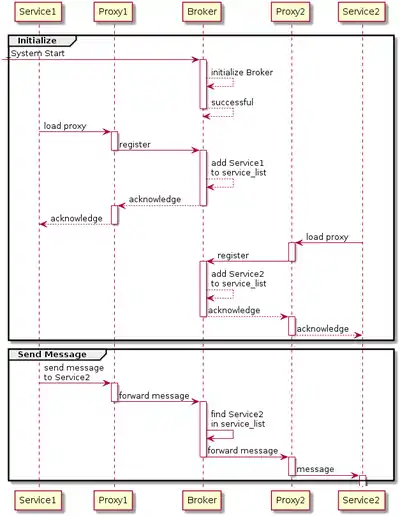Message broker
A message broker (also known as an integration broker or interface engine[1]) is an intermediary computer program module that translates a message from the formal messaging protocol of the sender to the formal messaging protocol of the receiver. Message brokers are elements in telecommunication or computer networks where software applications communicate by exchanging formally-defined messages.[1] Message brokers are a building block of message-oriented middleware (MOM) but are typically not a replacement for traditional middleware like MOM and remote procedure call (RPC).[2][3]

Purpose, functionality, and architecture
A message broker is an architectural pattern for message validation, transformation, and routing. It mediates communication among applications, minimizing the mutual awareness that applications should have of each other in order to be able to exchange messages, effectively implementing decoupling.[4]
The primary purpose of a broker is to take incoming messages from applications and perform some action on them. Message brokers can decouple end-points, meet specific non-functional requirements, and facilitate reuse of intermediary functions. For example, a message broker may be used to manage a workload queue or message queue for multiple receivers, providing reliable storage, guaranteed message delivery and perhaps transaction management. The following represent other examples of actions that might be handled by the broker:[2][3]
- Route messages to one or more destinations
- Transform messages to an alternative representation
- Perform message aggregation, decomposing messages into multiple messages and sending them to their destination, then recomposing the responses into one message to return to the user
- Interact with an external repository to augment a message or store it
- Invoke web services to retrieve data
- Respond to events or errors
- Provide content and topic-based message routing using the publish–subscribe pattern
Message brokers are generally based on one of two fundamental architectures: hub-and-spoke and message bus. In the first, a central server acts as the mechanism that provides integration services, whereas with the latter, the message broker is a communication backbone or distributed service that acts on the bus.[3] Additionally, a more scalable multi-hub approach can be used to integrate multiple brokers.[3]
List of message broker software
- Amazon Web Services (AWS) Amazon MQ
- Amazon Web Services (AWS) Kinesis
- Apache ActiveMQ
- Apache Artemis
- Apache Kafka
- Apache Qpid
- Apache Pulsar
- Cloverleaf (Enovation Lifeline - NL)
- Comverse Message Broker (Comverse Technology)
- Eclipse Mosquitto MQTT Broker (Eclipse Foundation)
- Enduro/X Transactional Message Queue (TMQ)
- Financial Fusion Message Broker (Sybase)
- Fuse Message Broker (enterprise ActiveMQ)
- Gearman
- Google Cloud Pub/Sub (Google)
- HiveMQ HiveMQ MQTT Broker
- EMQX EMQX MQTT Broker
- HornetQ (Red Hat) (Now part of Apache Artemis)
- IBM App Connect
- IBM MQ
- JBoss Messaging (JBoss)
- JORAM
- Microsoft Azure Service Bus (Microsoft)
- Microsoft BizTalk Server (Microsoft)
- MigratoryData (a very scalable message broker able to solve the C10M problem, i.e. 1000x more scalability than C10k problem)
- NATS (MIT Open Source License, written in Go)
- Open Message Queue
- Oracle Message Broker (Oracle Corporation)
- RabbitMQ (Mozilla Public License, written in Erlang)
- Redis An open source, in-memory data structure store, used as a database, cache and message broker.
- SAP PI (SAP AG)
- Solace PubSub+
- Spread Toolkit
- Tarantool, a NoSQL database, with a set of stored procedures for message queues
- TIBCO Enterprise Message Service
- WSO2 Message Broker
See also
References
- "IB (integration broker)". IT Glossary. Gartner, Inc. Retrieved 17 May 2018.
- Kale, V. (2014). "Integration Technologies". Guide to Cloud Computing for Business and Technology Managers: From Distributed Computing to Cloudware Applications. CRC Press. pp. 107–134. ISBN 9781482219227. Retrieved 17 May 2018.
- Samtani, G.; Sadhwani, D. (2013). "Integration Brokers and Web Services". In Clark, M.; Fletcher, P.; Hanson, J.J.; et al. (eds.). Web Services Business Strategies and Architectures. Apress. pp. 71–84. ISBN 9781430253563. Retrieved 17 May 2018.
- Ejsmont, A. (2015). "Asynchronous Processing". Web Scalability for Startup Engineers. McGraw Hill Professional. pp. 275–276. ISBN 9780071843669.
